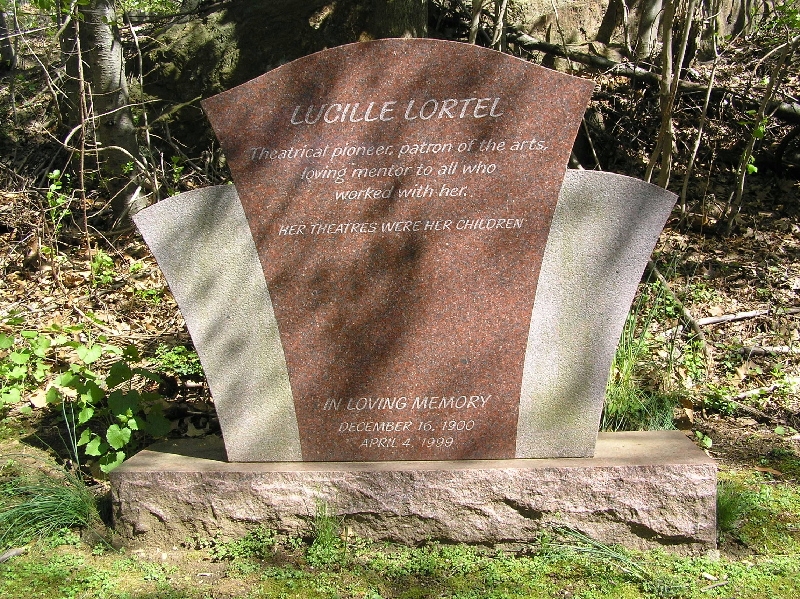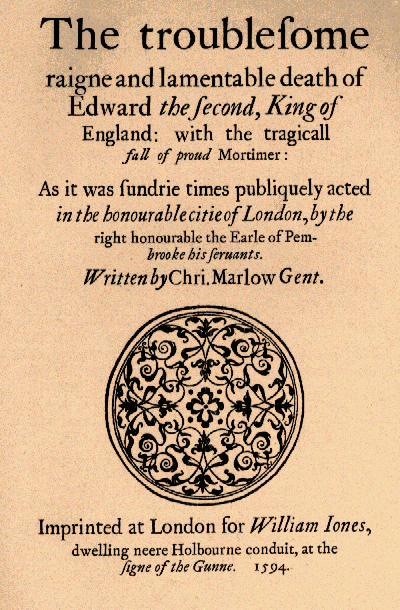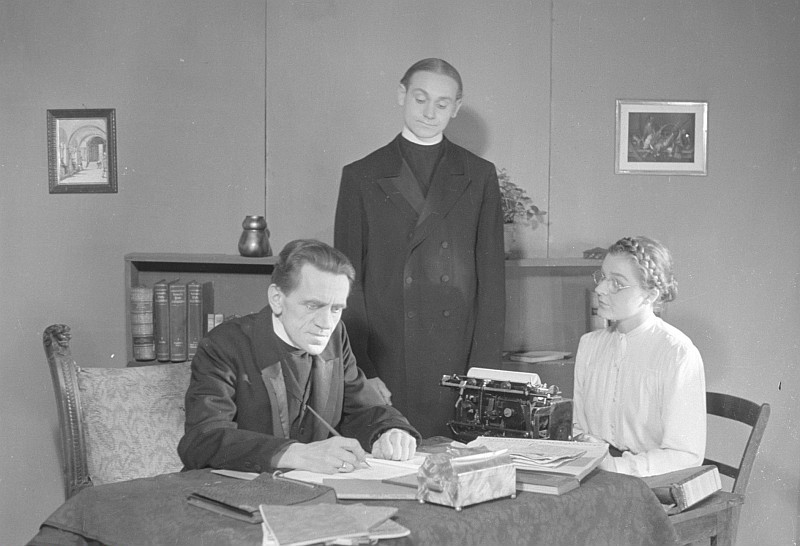|
Theatre De Lys
The Lucille Lortel Theatre is an off-Broadway playhouse at 121 Christopher Street in Manhattan's West Village. It was built in 1926 as a 590-seat movie theater called the New Hudson, later known as Hudson Playhouse. The interior is largely unchanged to this day. In the early 1950s, the site was converted to an off-Broadway theater as , opening on June 9, 1953, with a production of ''Maya'', a play by Simon Gantillon starring Kay Medford, Vivian Matalon, and Susan Strasberg. It closed after seven performances. Much more successful was ''The Threepenny Opera'' which opened March 10, 1954, with a cast that included Bea Arthur, John Astin, Lotte Lenya, Leon Lishner, Scott Merrill, Gerald Price, Charlotte Rae and Jo Sullivan. Because of an incoming booking, it was forced to close after 96 performances. Re-opening September 20, 1955, with largely the same cast, ''The Threepenny Opera'' this time played until December 17, 1961, a then record-setting run for a musical in New York City. ... [...More Info...] [...Related Items...] OR: [Wikipedia] [Google] [Baidu] |
Christopher Street
Christopher Street is a street in the West Village neighborhood of the New York City borough of Manhattan. It is the continuation of 9th Street west of Sixth Avenue. It is most notable for the Stonewall Inn, which is located on Christopher Street near the corner of Seventh Avenue South. As a result of the Stonewall riots in 1969, the street became the epicenter of the world’s gay rights movement in the late 1970s. To this day, the inn and the street serve as an international symbol of gay pride. Christopher Street is named after Charles Christopher Amos, the owner of the inherited estate which included the location of the street. Amos is also the namesake of nearby Charles Street, and of the former Amos Street, which is now West 10th Street. History Christopher Street is, technically, the oldest street in the West Village, as it ran along the south boundary of Admiral Sir Peter Warren's estate, which abutted the old Greenwich Road (now Greenwich Avenue) to the east an ... [...More Info...] [...Related Items...] OR: [Wikipedia] [Google] [Baidu] |
Lucille Lortel
Lucille Lortel (née Wadler, December 16, 1900 – April 4, 1999) was an American actress, artistic director, and theatrical producer. In the course of her career Lortel produced or co-produced nearly 500 plays, five of which were nominated for Tony Awards: ''As Is'' by William M. Hoffman, ''Angels Fall'' by Lanford Wilson, ''Blood Knot'' by Athol Fugard, Mbongeni Ngema's '' Sarafina!'', and '' A Walk in the Woods'' by Lee Blessing. She also produced Marc Blitzstein's adaptation of Bertolt Brecht and Kurt Weill's ''Threepenny Opera'', a production which ran for seven years and according to ''The New York Times'' "caused such a sensation that it...put Off-Broadway on the map." Early life and acting career Lortel was born Lucille Wadler on December 16, 1900, at 153 Attorney Street in the Lower East Side of Manhattan, one of four children of Anny and Harris Wadler, Jewish immigrants of Polish descent. Her father was a manufacturer of women's clothes who frequently traveled to Europ ... [...More Info...] [...Related Items...] OR: [Wikipedia] [Google] [Baidu] |
Philoctetes (Sophocles Play)
''Philoctetes'' ( grc, Φιλοκτήτης, ''Philoktētēs''; English pronunciation: , stressed on the third syllable, ''-tet-'') is a play by Sophocles (Aeschylus and Euripides also each wrote a ''Philoctetes'' but theirs have not survived). The play was written during the Peloponnesian War. It is one of the seven extant tragedies by Sophocles. It was first performed at the City Dionysia in 409 BC, where it won first prize. The story takes place during the Trojan War (after the majority of the events of the ''Iliad'', but before the Trojan Horse). It describes the attempt by Neoptolemus and Odysseus to bring the disabled Philoctetes, the master archer, back to Troy from the island of Lemnos. Background When Heracles was near his death, he wished to be burned on a funeral pyre while still alive. In the play ''Philoctetes'', Sophocles references the myth in which no one but Philoctetes would light Heracles' funeral pyre, and in return for this favor Heracles gave Philoctetes ... [...More Info...] [...Related Items...] OR: [Wikipedia] [Google] [Baidu] |
Blood Wedding
''Blood Wedding'' ( es, link=no, Bodas de sangre) is a tragedy by Spanish dramatist Federico García Lorca. It was written in 1932 and first performed at Teatro Beatriz in Madrid in March 1933, then later that year in Buenos Aires, Argentina. Theatre critics often group ''Blood Wedding'' with Garcia Lorca's ''Yerma'' and ''The House of Bernarda Alba'' as the "rural trilogy". Garcia Lorca's planned "trilogy of the Spanish earth" remained unfinished at the time of his death, as he did not include ''The House of Bernarda Alba'' in this group of works. Characters * La Madre – The Mother of the Groom * El Novio – The Groom * La Novia – The Bride * El Padre De La Novia – The Father of The Bride * Leonardo * La Mujer De Leonardo – Leonardo's wife * La Suegra de Leonardo – Leonardo's Mother-in-law * La Criada – The Maid * La Vecina – The Neighbour (woman) * Muchachas – Girls * La Luna – The Moon * La Muerte (como mendiga) – Death (as a beggar) * Leñadores – Wo ... [...More Info...] [...Related Items...] OR: [Wikipedia] [Google] [Baidu] |
Riders To The Sea
''Riders to the Sea'' is a play written by Irish Literary Renaissance playwright John Millington Synge. It was first performed on 25 February 1904 at the Molesworth Hall, Dublin, by the Irish National Theater Society with Helen Laird playing Maurya. A one-act tragedy, the play is set at Inishmaan in the Aran Islands, and like all of Synge's plays it is noted for capturing the poetic dialogue of rural Ireland. The plot is based not on the traditional conflict of human wills but on the hopeless struggle of a people against the impersonal but relentless cruelty of the sea. Background In 1897, J. M. Synge was encouraged by his friend and colleague William Butler Yeats to visit the Aran Islands. He went on to spend the summers from 1898 to 1903 there. While on the Aran island of Inishmaan, Synge heard the story of a man from Inishmaan whose body washed up on the shore of an island of County Donegal, which inspired ''Riders to the Sea''. ''Riders to the Sea'' is written in the Hib ... [...More Info...] [...Related Items...] OR: [Wikipedia] [Google] [Baidu] |
Edward II (play)
''The Troublesome Reign and Lamentable Death of Edward the Second, King of England, with the Tragical Fall of Proud Mortimer'', known as ''Edward II'', is a Renaissance or early modern period play written by Christopher Marlowe. It is one of the earliest English history plays, and focuses on the relationship between King Edward II of England and Piers Gaveston, and Edward's murder on the orders of Roger Mortimer. Marlowe found most of his material for this play in the third volume of Raphael Holinshed's ''Chronicles'' (1587). Frederick S. Boas believes that "out of all the rich material provided by Holinshed" Marlowe was drawn to "the comparatively unattractive reign of Edward II" due to the relationship between the King and Gaveston. Boas elaborates, "Homosexual affection ... has (as has been seen) a special attraction for Marlowe. Jove and Ganymede in ''Dido'', Henry III and his 'minions' in ''The Massacre'', Neptune and Leander in ''Hero and Leander'', and all akin, altho ... [...More Info...] [...Related Items...] OR: [Wikipedia] [Google] [Baidu] |
Candida (play)
''Candida'', a comedy by playwright George Bernard Shaw, was written in 1894 and first published in 1898, as part of his '' Plays Pleasant''. The central characters are clergyman James Morell, his wife Candida and a youthful poet, Eugene Marchbanks, who tries to win Candida's affections. The play questions Victorian notions of love and marriage, asking what a woman really desires from her husband. The cleric is a Christian Socialist, allowing Shaw—himself a Fabian Socialist—to weave political issues, current at the time, into the story. Shaw attempted but failed to have a London production of the play put on in the 1890s, but there were two small provincial productions. However, in late 1903 actor Arnold Daly had such a great success with the play that Shaw would write by 1904 that New York was seeing "an outbreak of Candidamania". The Royal Court Theatre in London performed the play in six matinees in 1904. The same theatre staged several other of Shaw's plays from 1904 t ... [...More Info...] [...Related Items...] OR: [Wikipedia] [Google] [Baidu] |
Pelléas And Mélisande
''Pelléas and Mélisande'' (french: Pelléas et Mélisande) is a Symbolist play by Maurice Maeterlinck about the forbidden, doomed love of the title characters. It was first performed in 1893. The work never achieved great success on the stage, apart from in the operatic setting by Claude Debussy, but it was at the time widely read and admired by the literary elite in the symbolist movement, such as Strindberg and Rilke. It also inspired other contemporary composers, including Gabriel Fauré, Arnold Schoenberg, Jean Sibelius, and Mel Bonis. Synopsis Golaud finds Mélisande by a stream in the woods. She has lost her crown in the water but does not wish to retrieve it. They marry, and she instantly wins the favor of Arkël, Golaud's grandfather and king of Allemonde, who is ill. She begins to be drawn to Pelléas, Golaud's brother. They meet by the fountain, where Mélisande loses her wedding ring. Golaud grows suspicious of the lovers, has his son Yniold spy on them, and discov ... [...More Info...] [...Related Items...] OR: [Wikipedia] [Google] [Baidu] |
Hamlet
''The Tragedy of Hamlet, Prince of Denmark'', often shortened to ''Hamlet'' (), is a tragedy written by William Shakespeare sometime between 1599 and 1601. It is Shakespeare's longest play, with 29,551 words. Set in Denmark, the play depicts Prince Hamlet and his attempts to exact revenge against his uncle, Claudius, who has murdered Hamlet's father in order to seize his throne and marry Hamlet's mother. ''Hamlet'' is considered among the "most powerful and influential tragedies in the English language", with a story capable of "seemingly endless retelling and adaptation by others". There are many works that have been pointed to as possible sources for Shakespeare's play—from ancient Greek tragedies to Elizabethan plays. The editors of the Arden Shakespeare question the idea of "source hunting", pointing out that it presupposes that authors always require ideas from other works for their own, and suggests that no author can have an original idea or be an originator. When ... [...More Info...] [...Related Items...] OR: [Wikipedia] [Google] [Baidu] |
Cry, The Beloved Country
''Cry, the Beloved Country'' is a 1948 novel by South African writer Alan Paton. Set in the prelude to apartheid in South Africa, it follows a black village priest and a white farmer who must deal with news of a murder. American publisher Bennett Cerf remarked at that year's meeting of the American Booksellers Association that there had been "only three novels published since the first of the year that were worth reading… ''Cry, The Beloved Country'', ''The Ides of March'', and ''The Naked and the Dead''.""Reader's Digest: Gossip, news: J. F. Albright reports on A.B.A. meeting," ''The Dallas Morning News'', 30 May 1948, p. 6. It remains one of the best-known works of South African literature. Two cinema adaptations of the book have been made, the first in 1951 and the second in 1995. The novel was also adapted as a musical called ''Lost in the Stars'' (1949), with a book by the American writer Maxwell Anderson and music composed by the German emigre Kurt Weill. Plot The story ... [...More Info...] [...Related Items...] OR: [Wikipedia] [Google] [Baidu] |
The Knight Of The Burning Pestle
''The Knight of the Burning Pestle'' is a play in five acts by Francis Beaumont, first performed at Blackfriars Theatre in 1607 and published in a quarto in 1613. It is the earliest whole parody (or pastiche) play in English. The play is a satire on chivalric romances in general, similar to ''Don Quixote'', and a parody of Thomas Heywood's ''The Four Prentices of London'' and Thomas Dekker's ''The Shoemaker's Holiday''. It breaks the fourth wall from its outset. Text It is most likely that the play was written for the child actors at Blackfriars Theatre, where John Marston had previously had plays produced. In addition to the textual history testifying to a Blackfriars origin, there are multiple references within the text to Marston, to the actors as children (notably from the Citizen's Wife, who seems to recognise the actors from their school), and other indications that the performance took place in a house known for biting satire and sexual innuendo. Blackfriars specialis ... [...More Info...] [...Related Items...] OR: [Wikipedia] [Google] [Baidu] |
The Little Clay Cart
''The'' () is a grammatical article in English, denoting persons or things already mentioned, under discussion, implied or otherwise presumed familiar to listeners, readers, or speakers. It is the definite article in English. ''The'' is the most frequently used word in the English language; studies and analyses of texts have found it to account for seven percent of all printed English-language words. It is derived from gendered articles in Old English which combined in Middle English and now has a single form used with pronouns of any gender. The word can be used with both singular and plural nouns, and with a noun that starts with any letter. This is different from many other languages, which have different forms of the definite article for different genders or numbers. Pronunciation In most dialects, "the" is pronounced as (with the voiced dental fricative followed by a schwa) when followed by a consonant sound, and as (homophone of pronoun ''thee'') when followed by a v ... [...More Info...] [...Related Items...] OR: [Wikipedia] [Google] [Baidu] |






.png)